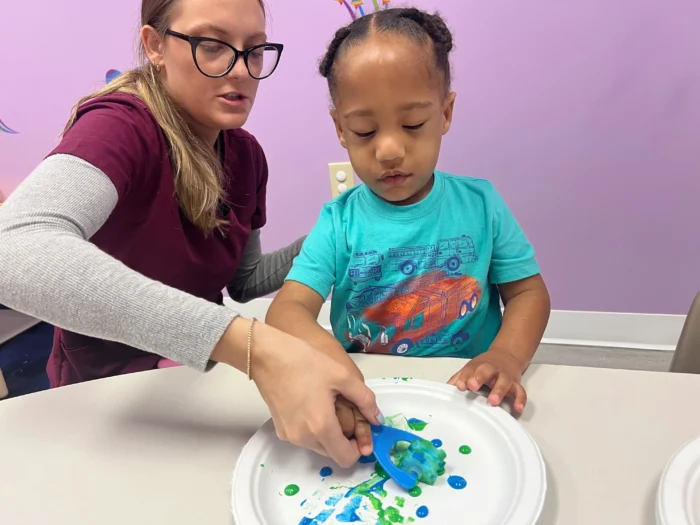
When exploring support options for children with Autism Spectrum Disorder, ABA therapy often emerges as a leading choice. It has demonstrated significant success in helping children develop communication skills, enhance learning abilities, and engage more effectively with their environment.
However, like any therapeutic approach, it has sparked important discussions about its methods and impact.
This article will walk you through what ABA can do, address some of the concerns you might have heard, and explain why many families, maybe just like yours, find it beneficial.
Why Is ABA Therapy Considered Harmful for Autism?
The evolution of ABA from its early days to current practices has been marked by significant changes and ongoing discussions. It’s important to address the concerns and controversies that have arisen about it, as well as examine its effectiveness and benefits for children with ASD.
ABA Uses Aversive Methods and Punishment
Early ABA therapy practices included aversive methods, including severe forms such as electric shock therapy. These historical punishment-based practices have contributed to ongoing concerns about ABA therapy.
However, modern ABA therapy has transformed completely. Today’s approaches focus entirely on positive reinforcement and supportive strategies that encourage learning and development. Current ABA practices prioritize each child’s well-being and emotional security while building essential skills.
To make sure about the whole process, you can prepare a list of detailed ABA questions for the therapy provider you have in mind.
ABA Causes Trauma and PTSD
Critics have expressed concern that ABA therapy can be overwhelming for autistic children, suggesting that traditional approaches were too rigid and focused heavily on compliance.
Some argue that these methods prioritized meeting external expectations over nurturing the child’s natural development.
These concerns are particularly relevant for children who struggle with communication. Some have worried about potential negative emotional impacts, including PTSD in autistic kids, anxiety, and depression.
Contemporary ABA therapy techniques address these concerns by:
- Creating supportive, engaging environments
- Adapting to each child’s communication style
- Monitoring emotional well-being throughout therapy
- Adjusting approaches to make children feel safe, valued, and motivated
If challenges arise, therapists can modify their approach or explore alternatives to ABA therapy such as CBT (cognitive behavioral therapy) or DBT (dialectical behavior therapy).
ABA Wants to “Normalize” Autistic Kids
Another argument for why ABA therapy is bad is that ABA therapy aims to remove autistic traits to make children appear “normal” by societal standards. This concern often stems from misunderstanding modern ABA’s goals and suggests a one-size-fits-all approach that doesn’t align with current practices.
Today’s ABA therapy celebrates neurodiversity and each child’s unique qualities. The focus is on developing skills that enhance quality of life while respecting individual differences and personalities.
Let’s delve deeper into what ABA therapy stands for nowadays and what Abacus Therapies is about.
ABA Therapy: The Gold Standard in Autism Treatment
Applied Behavior Analysis therapy maintains its position as a leading approach to autism treatment, backed by extensive research and positive outcomes.
Key Benefits of ABA Therapy
ABA therapy offers numerous benefits by focusing on each child’s unique needs and learning style. The goal is to tailor therapy to fit the child, improving their overall quality of life.
Whether in a home, school, or specialized center setting, therapy is mostly based on positive reinforcement. When children achieve milestones or demonstrate progress, they receive praise and encouragement, reinforcing their success and motivating them to continue learning.
Our ABA therapists work closely with families to set meaningful goals that align with each child’s strengths and challenges. We help children build new skills while navigating behavioral challenges effectively.
Abacus Therapies’ approach ensures that ABA therapy remains a tool for growth, empowerment, and long-term success.
Proven Effectiveness
ABA’s effectiveness is well-documented through over fifty years of scientific research. Children receiving ABA therapy often show significant progress in:
- Intellectual capabilities
- Communication skills
- Daily living abilities
- Social participation
- Academic performance
At Abacus Therapies, we regularly witness progress in both verbal and non-verbal communication, with children developing new ways to express their thoughts and needs effectively.
Forward Together with ABA
Modern ABA therapy has evolved significantly since its inception in the 1960s. Today’s approaches emphasize other aspects:
- Rewards take center stage to promote constructive actions
- Sensory-friendly activities are commonly included in treatments
- Families are given tools and training to provide support outside of therapy sessions
Our commitment at Abacus Therapies focuses on supporting each child’s development while working closely with families to ensure therapy aligns with their goals and values.
FAQs
What trauma is caused by ABA therapy?
ABA therapy can be tough for some. It may cause stress or discomfort due to its structured nature and repetitive tasks, and if it feels too intense, it may trigger some PTSD symptoms, particularly in those who are more sensitive.
Therapy should always be comfortable for everyone involved. Consult with the therapist if you notice any signs of stress or harm, so they can adjust the treatment plan to reduce discomfort and make sure the child feels supported and safe.
While historical approaches to ABA could be stressful for some children, modern therapy prioritizes emotional well-being and adjusts to each child’s comfort level. Any signs of distress are addressed immediately, with modifications made to ensure therapy feels safe and supportive.
What do autistic people think about ABA?
Many autistic people have shared their experience with ABA therapy, and they claim that it provided them with valuable support. Research also shows that ABA is beneficial.
However, not everyone feels the same way. There are people within the ASD who didn’t find ABA helpful in the way they hoped.
Is ABA good for high-functioning autism?
Some think ABA isn’t for kids who are high functioning, but that’s not the case. The therapy can be customized to suit these children’s strengths while also addressing their challenges, like helping them master daily tasks, improve conversation skills, manage emotions, and achieve independence.



